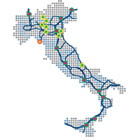Resolution ARG/gas 184/09 - “Approval of part II – Regulation of the tariffs for the natural gas transportation and dispatch service for regulatory period 2010-2013 (RTTG), approval of part III - Regulation of tariffs for the gas transportation metering service for regulatory period 2010-2013 (RMTG), provisions on the transitory fee for the gas transportation metering service for 2010 and amendments to Attachment A of Resolution 11/07”.
With Resolution ARG/gas 184/09, published on 2 December 2009, the Electricity and Gas Authority issued the criteria for defining natural gas transportation and measuring tariffs on the National and Regional Transportation Network for the third regulatory period (1 January 2010 - 31 December 2013).
The valuation of the net capital invested (RAB) is based on the revalued historic cost method. The return rate (WACC) of net capital invested is set at a real rate of 6.4% before taxes.
The incentives for new investments were confirmed and provide for a higher return compared to the variable base rate (WACC), in relation to the type of investment, from 1% to 3% and for a period from 5 to 15 years. The revenues associated with new investments are paid starting from the second year following that in which the costs were incurred (“spending”) and are guaranteed regardless of the volumes transported.
The method for updating the price cap tariffs is applied to revenue relating to operating costs and is equal to approximately 15% of the revenues in question, which are updated for inflation and decreased by an annual recovery coefficient set at 2.1% (3.5% in the previous regulatory period). The revenue components which are related to returns and amortisation and depreciation are determined on the basis of the annual update of net capital invested (RAB). In particular, in the third regulatory period, the amortisation and depreciation is deducted from the price-cap mechanism and calculated on the basis of the useful economic and technical life of the transport infrastructure which is 50 years (40 years in the previous regulatory period).
The tariff structure is based on an entry/exit model and was confirmed for the third regulatory period as well, together with the capacity fee for the metering service.
Finally, fuel gas is treated as a pass-through cost which is payable in kind by the users and is excluded from the price cap mechanism.
Resolution ARG/gas 218/10 - “Approval of the tariff proposals for natural gas transportation and dispatch, the transitory fee for the gas transportation metering service for 2011 in implementation of the provisions set forth in Resolution ARG/gas 184/09 issued by the Electricity and Gas Authority on 1 December 2009.”
Based on the criteria described, the Electricity and Gas Authority approved the transportation, dispatch and metering tariffs for 2011 with Resolution ARG/gas 218/10.
The tariffs were determined on the basis of the base revenues which amounted to €1,817 million net of the third party portion (of which €113 million relate to development investment incentives and approximately €36 million to revenues associated with system balancing costs).
The revenues in effect from 2011 have taken into account the increase in volumes transported compared to the base amount of 75.7 billion cubic metres.
Furthermore, the amount payable to the company for higher costs incurred for the purchase of fuel gas from 1 October 2008 to 31 December 2009 was set at €54.9 million.
The RAB as at 31 December 2009 for transportation, dispatch and metering amounts to €13.1 billion.
Resolution ARG/gas 45/11 - “Regulation for the financial balancing of natural gas”.
By this resolution, published on 14 April 2011, the Authority intended to reform the regulation of dispatch, transportation and storage of natural gas from 1 July 2011, a date postponed to 1 December 2011 by Resolution ARG/gas 81/11 published on 23 June 2011, by introducing a new balancing regime based on market criteria and attributing Snam Rete Gas, as the majority transportation company, the role of company responsible for balancing. This role provides Snam Rete Gas with an obligation to acquire, according to criteria of financial merit, the resources necessary to guarantee the safety and efficient movement of gas from entry points to the withdrawal points, in order to maintain the constant equilibrium of the network.
The provision provides for an initial phase of simplified balancing, which does not amend the current methods of physical dispatching on the network and is based on using the stock of users as the sole balancing resource, selected according to criteria of financial merit. Starting from early 2012, the resolution also set out an extension of the regulatory framework aimed at developing the discipline of the balancing service.
Resolution ARG/gas 178/11 - “Approval of the tariff proposals for natural gas transportation and dispatch, and the transitory fee for the gas transportation metering service for 2012 in implementation of the provisions set forth in Resolution ARG/gas 184/09 issued by the Electricity and Gas Authority on 1 December 2009”.
The Authority approved the transportation, dispatch and metering tariffs for 2012 by Resolution ARG/gas 178/11.
The tariffs were determined on the basis of the base revenues which amounted to €1,862 million net of the third party portion (of which approximately €113 million relate to development investment incentives and approximately €41 million to revenues associated with system balancing costs).
The revenues in effect in 2012 will have to take account of the increase in volumes transported compared to the base amount of 75.7 billion cubic metres.
The RAB as at 31 December 2010 for transportation, dispatch and metering amounts to €13.7 billion.



